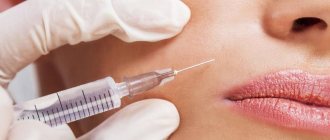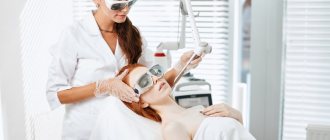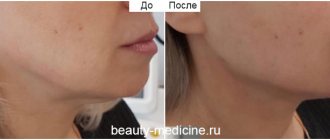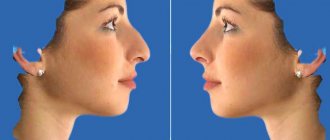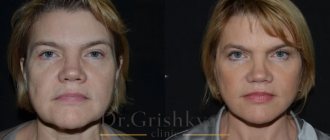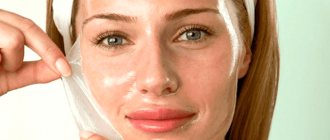“When blood supply and nervous regulation are perfect, when all parts of the body move in harmony and know what each other needs, there is health in the body” - Andrew Taylor Still, founder of osteopathy.
Osteopathic cosmetology is a section of osteopathic therapy aimed at restoring health to facial tissues, natural color and turgor of the skin (capillary blood flow), optimal function (facial muscles).
Aesthetic manual facial modeling is an alternative to surgical methods of rejuvenation and correction of facial contours.
Effect of osteopathic facial modeling
During osteopathic manual modeling of the face, there is a deep impact on the facial tissues and self-healing of the facial muscle frame. Using certain techniques, the specialist relieves spasms, achieves muscle relaxation and allows the facial muscles to assume a natural position.
Due to the deep effect on the tissue, lymphatic drainage occurs - “pumping” of intercellular fluid, blood microcirculation in the subcutaneous tissues improves, and metabolic processes are activated. The skin tightens and acquires a healthy color.
Osteopathic cosmetology suggests not trying to change the skin itself (i.e. the consequences), but looking for and eliminating the causes.
Causes of lymphatic congestion in the face
Uncompensated psycho-emotional reactions, leading to a protective spasm of the facial muscles, play an important role in the disruption of lymphatic drainage in the facial area. In this regard, tissue metabolism deteriorates and thereby aggravates the spasmodic state of the facial muscles - the most “reliable” way to acquire deep wrinkles, a double chin, “sliding cheeks and drooping eyelids.” All this leads to an imbalance of muscle tone and, accordingly, to visible deformation of the face and a change in its expression. Disruption of the normal relationships and functions of the bones of the facial skull and especially the lower jaw also affects the drainage system of the soft tissues of the face.
Using special manual techniques, the balance of muscles and ligaments in the face, neck and décolleté is restored.
Aesthetic problems of the face and neck owe their appearance to three main factors:
- Myofascial dysfunction (impaired tone, both upward and downward).
- Lymphatic drainage disorders.
- Changes in the positions of the facial skull.
The appearance of deep wrinkles due to deformation of connective tissue fibers is a consequence of these factors.
Before the session
Before you begin the massage, you need to do a little preparatory work:
- Remove ear and neck jewelry.
- Hide your hair under a special cap.
- Wash off your makeup.
- Using the scrub, thoroughly cleanse your face.
- Apply a pre-selected massage product. It can be oil, modeling cream or gel. Many practitioners prefer to use talc because it provides greater contact with the skin.
- If you are giving yourself a massage, remember that your hands should be clean, dry, and your nails short.
The psychological attitude towards the procedure is also important: complete relaxation, the absence of negative thoughts, and a comfortable environment will enhance the rejuvenating effect.
Reasons for the formation of facial wrinkles
Wrinkles are a pathological microspasm of facial muscles, also often fixed by inadequate psychological attitudes - “personal masks” of the face - the basis for the formation of wrinkles, disturbances in the trophism / “nutrition” of the skin with the formation of areas of depletion, age spots.
For example: Consequences of stress. A person unconsciously clenches his teeth, thereby causing a spasm of the chewing muscles. When the distance between the top and bottom of the masseter muscle begins to decrease, it is forced to deform and “twist.” Since it is attached to the bones at both ends, the skin of the cheek does not sag, but is pulled up along with the muscle. At the same time, in the area of the chin, the lower jaw moves down and changes its inclination; as a result of this process, the skin of the “jowls” in the area of the angle of the lower jaw begins to appear saggy.
During osteopathic manual facial modeling, a specialist performs a complex effect at all levels:
- intraosseous – the consequences of bruises and other head injuries are worked out, which affect the state of the whole organism, our mood and behavior;
- vascular - the vessels of the head are worked out, which improves not only blood circulation in the tissues of the face, but also in the brain, which affects the reduction of the level of depression, despondency, etc.;
- neuro-endocrine – hormonal regulation of the vital functions of the body occurs, which expands the possibilities for correcting many cosmetic problems and allows one to obtain pronounced and lasting positive aesthetic and somatic-psychic effects;
- lymphatic – lymphatic drainage improves the circulation of lymph and interstitial fluid, improving metabolic processes in tissues;
- energetic – energy meridians connected with internal organs pass through the face. The condition of the skin and muscle tone in the area of the meridian reflects the condition of the internal organ. Normalizing energy circulation improves the general condition of the body, improves the functioning of internal organs;
- psychodynamic techniques allow you to normalize your internal state and “return everything to its place,” including the correction of states that are described by the words “I lost my temper,” “my head is out of place,” etc.
- soft manual techniques can make fibrous muscles more elastic, reduce wrinkles and folds on the face;
Handmade
Massage has been known since ancient times - it was used for medicinal and cosmetic purposes in ancient Egypt, Greece and Rome.
In the Middle Ages, when scientists became actively interested in human anatomy, its basic techniques for the face and body were described and then scientifically substantiated. Today, facial massage is a necessary part of cosmetic skin care. No device can reproduce the feeling of relaxation and calm that the skillful hands of a cosmetologist bring. That is why manual massage is one of the most effective and safe procedures for facial skin. And if you follow the principle of regularity, the lifting effect will be an excellent alternative to cosmetic injections.
— Facial massage today is more fashionable than high-tech serums and creams, —
Confirms Inna Plakhtienko.
“This is the most important step in daily care; it helps improve blood circulation, restore smoothness and healthy glow to the skin, and even solve some age-related problems: smooth out fine wrinkles, for example.
There are different types and schools of cosmetic massage. The choice is so diverse that it can be extremely difficult to settle on the right option. Each variety has its own characteristics, indications and contraindications. Therefore, depending on the skin type, the cosmetologist selects the type of massage and the necessary cosmetic product - an auxiliary tool that will increase the effectiveness of the procedure.
It is ideal if the massage technique and cosmetic product work in the same direction. For example, it is recommended to finish plastic facial massage for wrinkles and decreased skin turgor by applying an active anti-aging serum and a lifting mask on top of it.
Indications for osteopathic facial modeling
Facial modeling using osteopathic treatment is recommended to eliminate the following aesthetic defects:
- puffiness of the face
- pastiness of the eyelids and entire face
- decreased muscle tone;
- dryness and sagging facial skin;
- asymmetry of the corners of the mouth, eyes
- myofascial reversible deep and fine wrinkles
- double chin
- tension of facial and chewing muscles
- greasy shine, blackheads, pimples, enlarged pores.
Contraindications
Modeling facial massage techniques are comparable to plastic surgery in terms of impact and effectiveness. It is important to remember that such a deep and intensive study of the body’s structures is not harmless and can significantly harm health if:
- oncology;
- blood poisoning;
- herpes;
- hernia of the cervical or thoracic spine;
- low blood pressure;
- trigeminal neuralgia;
- allergies;
- inflammatory skin diseases;
- dermatitis;
- a large number of moles or papillomas;
- fresh wounds, abrasions, burns, frostbite;
- rosacea.
It is not recommended to do the procedure after recent chemical peeling, Botox injections, biorevitalization, contouring and mesotherapy sessions.
What can be called a tissue “disease” from the perspective of osteopathic cosmetology?
The following conditions can be called tissue “diseases”:
- puffy cheeks;
- swelling under the eyes;
- double chin;
- wrinkle network;
- bite distortion.
The reason for all these conditions lies precisely in the disruption of blood supply, lymphatic drainage and innervation (the supply of organs and tissues with nerves, which ensures their connection with the central nervous system).
Unfortunately, there are many options for the formation of wrinkles and various distortions and each specific case must be examined individually.
Photos "before" and "after"
Surgical thread lift using Waylock threads (V-lock threads) in the cheek-zygomatic area and in the oval area of the face. Surgiderm 24xp hyaluronic acid filler for lips, nasolabial folds and labio-mental wrinkles. In the photo: “before” and 2 days after the procedure. Completed by: Vasiliev Maxim.
Methodology of the osteopathic aesthetic protocol “Attractive Face”
- The duration of the procedure is 60 minutes.
- The frequency of procedures is 2 times a week.
- The minimum number of procedures is 3-5 (the number of procedures depends on the patient’s age and the condition of the facial skin);
- The optimal number of procedures is 5 – 8 (the number of procedures depends on the patient’s age and the condition of the facial skin);
- Positive changes are noticed after 1-2 sessions.
It is recommended, in parallel with osteopathic facial modeling, to undergo a lymphatic drainage massage procedure (from the lumbar area of the body to the feet) using the LimphoPress apparatus (Israel).
Lifting procedures for deformation type of aging
With the deformation type of aging, facial fat packets are pronounced; as they fall down, they form jowls, and the oval of the face looks swollen. The name of this type of aging speaks for itself - with age, patients prone to this type of aging experience deformation of facial contours. Procedures most suitable for patients with deformational type of aging: facial massage, microcurrent therapy, ultrasonic SMAS lifting, thread lifting.
Facial massage and microcurrent therapy
If you are prone to deformation-type aging, prevention of ptosis is very important. For prevention, regular facial massages and microcurrent therapy are recommended. These procedures help relieve swelling and stimulate lymphatic drainage. It is advisable to start these procedures no later than 30 years of age. In the future, they can be used in breaks between more serious medical lifting procedures to maintain the effect.
Ultrasonic SMAS lifting
If signs of ptosis appear, the optimal combination of ultrasonic SMAS lifting and the installation of threads with notches will be optimal. Focused ultrasound penetrates to a greater depth, to the level of facial fat packets and SMAS (superficial muscular aponeurotic system of the face), the energy destroys fat cells in areas of sagging and stimulates collagen production in the muscular aponeurotic system. The procedure is carried out once, no course is required. The effect begins to appear after a month and increases over six months. After a year, the ultrasonic SMAS lifting procedure can be repeated. In our clinic, this procedure is performed using the Ultraformer III device.
Thread lifting
The installation of threads with notches in the deformation type of aging is used not so much for the sake of lifting (the tissues of such patients are heavy, so the threads will not provide lasting lifting), but rather for the sake of forming a subcutaneous connective tissue frame. The threads stimulate the production of collagen, which will hold the tissues in the desired position, preventing them from sagging. Therefore, it is better not to tighten the installation of threads, and not to wait until the fabrics go down significantly. In cosmetology, the most popular are absorbable threads made of polylactic acid - Aptos and threads made of polydioxanone - KOGI. The procedure is performed under local anesthesia, the recovery period is about a week. The effect lasts for 1-3 years, after which the procedure can be repeated. At the very first signs of ptosis, you can get by with liquid mesothreads (Estefill) or stimulate collagen production with Radiesse.
